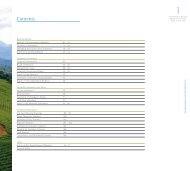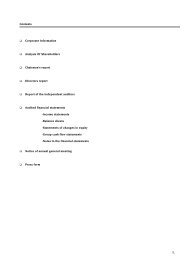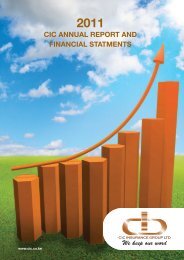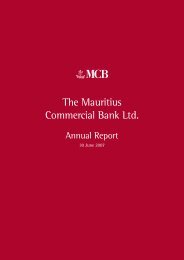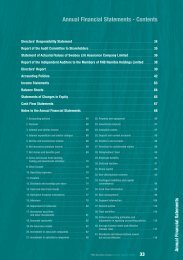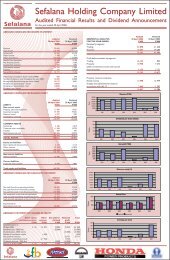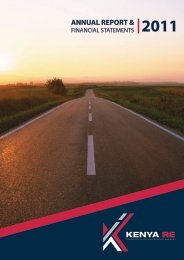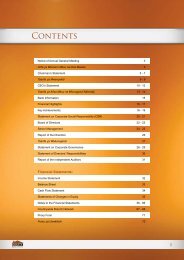Financial Statements 2011 - Investing In Africa
Financial Statements 2011 - Investing In Africa
Financial Statements 2011 - Investing In Africa
Create successful ePaper yourself
Turn your PDF publications into a flip-book with our unique Google optimized e-Paper software.
Notes To The <strong>Financial</strong> <strong>Statements</strong> (Continued)<br />
As at 31 december <strong>2011</strong><br />
4) <strong>Financial</strong> risk management objectives (continued)<br />
Group risk management framework and governance structures (continued)<br />
b) Liquidity and funding risk (continued)<br />
III<br />
Exposure to liquidity risk<br />
c) Market risk<br />
The key measures used by the Group for managing liquidity risk are;<br />
• The ratio of net liquid assets to deposits from customers (liquidity ratio). For this purpose, net liquid assets<br />
include cash and cash equivalents and investments in securities for which there is an active and liquid market<br />
less any deposits from banks, as well as other borrowings and commitments maturing within the next month.<br />
The banking regulators require that the Group maintains a cash reserve ratio computed as percentage of eligible<br />
customer deposits.<br />
The banking regulations require that the Group maintains a minimum liquidity ratio of 20%. The Group complied<br />
with the liquidity requirements during the year.<br />
The average liquidity ratio for the year was 30% (2010 – 34%).<br />
• The maturity analysis of assets and liabilities report (note 43 (a)). The Group uses the maturity mismatch ladders<br />
to compare cash inflows and outflows each month and over a series of time-bands. The maturity mismatch<br />
ladder shows the net cash flows of the Group in various time bands. The Group’s net funding requirements are<br />
determined by analysing present and future cash flows of the entire statement of financial position at selected<br />
maturity dates, based on assumptions of the behaviour of assets, liabilities and off-balance sheet items.<br />
Calculations will include the cumulative net excess or shortfall over the time frame of the liquidity assessment.<br />
The Group also monitors its liquidity exposures through an array of internally developed risk indicators such as<br />
advances to deposit ratios, proportion of largest depositors to total deposits, liquidity gap analysis ratios, interbank<br />
borrowings as a proportion of total deposits, amongst others. This enables the Group to arrest any early<br />
warning signs and take timely corrective action.<br />
As part of the ALCO function, Treasury receives information from business units regarding the liquidity profile<br />
of their financial assets and liabilities plus details of other projected cash flows arising from projected future<br />
business. Treasury then maintains a portfolio of short-term liquid assets, largely made up of short-term liquid<br />
investment grade securities, loans and advances to banks and other inter-bank facilities, to ensure that sufficient<br />
liquidity is maintained within the Group as a whole. The liquidity requirements of business units and subsidiaries<br />
are met through various funding options to cover any short-term fluctuations and longer term funding to address<br />
any structural liquidity requirements.<br />
The table in note 43 (b) presents cash flows payable by the Group under financial liabilities by remaining<br />
contractual maturities at the reporting date and the cash flows receivable from financial assets by expected<br />
maturity date. The amounts disclosed in the table are the contractual undiscounted cash flows, whereas the<br />
Group manages the liquidity risk based on a different basis (note 43 (a)), not resulting in a significantly different<br />
analysis.<br />
Market risk is the risk that the values of assets and liabilities or revenues will be adversely affected by changes in market<br />
conditions or market movements. Market risks in the Group arise from movements in market prices particularly changes in<br />
interest rates, foreign currency exchange rates, fixed rate securities and equity prices which we are exposed to. It is often<br />
propagated by other forms of financial risks such as credit and market liquidity risk events. The objective of market risk<br />
management programs is to manage and control market risk exposures in order to optimise return on risk taken while<br />
maintaining a good market profile as a provider of financial products and services.<br />
Who manages market risk<br />
The Board Risk Management Committee reviews and approves market risk policies and limits periodically or as need arises.<br />
The Treasury department in consultation with the Risk Management Department are responsible for the development<br />
of detailed market risk management policies, subject to review and support by ALCO and approval by the Board Risk<br />
Management Committee. The Board receives quarterly reports of market risk exposures or activities through relevant ALCO<br />
minutes, and Treasury reports outlining current risk exposures against risk limits.<br />
NIC Bank Limited • Annual Report & <strong>Financial</strong> <strong>Statements</strong> <strong>2011</strong> • 63




